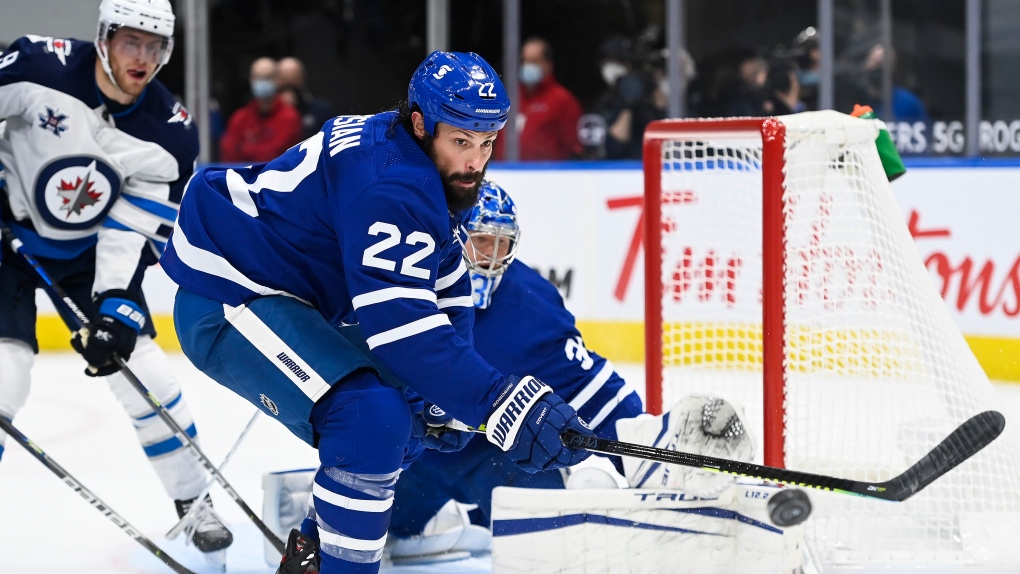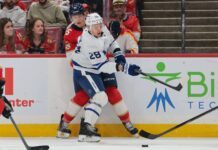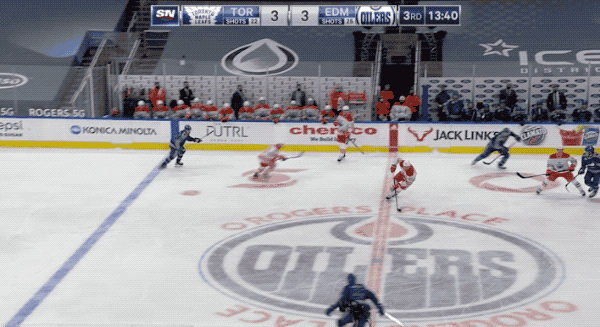On Episode 1 of the MLHS podcast, Ian Tulloch and Anthony Petrielli debated the play of the TJ Brodie – Morgan Rielly pairing, Morgan Rielly’s rush-defense vulnerabilities, the safe minutes of Zach Bogosian, and the sterling play of the Jake Muzzin – Justin Holl pairing.
Support the MLHS Podcast on Patreon
Early-release full-length video episodes are available to our patrons each week:
Ian Tulloch: Let’s talk about the Leafs defense. That was a big concern that we have had over the last few years.
The Leafs tried to address it by bringing in TJ Brodie. They traded away Kasperi Kapanen and Andreas Johnsson, two guys who were making a lot of money — that third line was making $11 million and didn’t produce in the playoffs. Ergo, let’s replace these guys for some cheaper depth. We are a team that is built on our scoring talent up front. We know star players are what really drive results, so let’s play these star players with some complimentary, cheaper depth. It will help us acquire that blue chip, top-four defenseman in TJ Brodie.
They brought TJ Brodie in, and so far, for the Rielly-Brodie pairing, the results are below 50% in shots, scoring chances — all of the important metrics. They are getting out-played at even strength. You can talk about the difficulty of their minutes, but also look at who they play with.
Petrielli: They aren’t the top shutdown pairing, though. Their minutes are not easy, but they are not going against the best players.
Tulloch: They are some nights, and other nights, it is Muzzin-Holl. It is a bit flip-floppy. The bigger concern is that they’re getting outplayed. And I don’t think it is TJ Brodie’s fault.
Petrielli: Other than that one game. That was the Ottawa game in game #2 of the season. That was the flashback Jake Gardiner game.
Tulloch: I think when we are evaluating defense at the NHL level, you have to accept there are going to be games like that over the course of the season. You are just going to have a game where nothing goes right and the puck goes into the back of the net a lot.
Petrielli: Brodie is a good player. If he has that game one every 10, I won’t say a word. That is what you get for $5 million. If you want better than that, you have to pay more than five. That is what he did in the first 10 because he has been solid otherwise. Ultimately, I am not going to complain. I don’t think he can run a power play, but I am not going to complain.
Tulloch: When we are talking about TJ Brodie at 5v5, what I have really liked from him is his gap in the neutral zone. I feel like he does a much better job than some of Toronto’s other defensemen — i.e. Morgan Rielly — at taking away that space from opposing forwards.
You look at the ability to defend the rush in the modern NHL, and that is how you prevent goals. Teams are scoring mostly off of the rush — I want to say three-quarters of goals come off of the rush within 5-10 seconds of gaining the blue line. Once you are facing a set defense — and Sheldon Keefe has talked about this a lot — when the other team gets set defensively and you are going up against a four or five-man unit in its own end, it is very hard to break that down.
We have seen the Leafs a few times this season stuck with the puck on the perimeter, where they are trying to break down the defense, but it is hard. When you have a team that can set itself up with four or five guys packed in the slot — “park the bus” — it is hard to break that down.
You want to be able to create offense off of the rush offensively. The best way to defend that is by maintaining a tight gap in transition, not letting them gain the zone, and not letting them make a pass after gaining the zone.
If you look at Morgan Rielly, there is so much space that he is giving opposing forwards when they are breaking down. A two-on-two rush, a three-on-three rush — just basic hockey plays — and they are gaining the zone cleanly and they are creating a cycle. Now you are stuck in your own end, and bad things are happening.
We know he is a skilled offensive player, but over the course of the last few years, the excuse has been: Well, he has bad partners — the quality of teammates. Who has he had over the last couple of years? Tyson Barrie, Ron Hainsey…
Petrielli: Cody Ceci last year. Arguably worse. I don’t know who is worse between Ceci and Barrie, but either way.
Tulloch: That has always been my excuse for Rielly. Get this guy a top-four partner, and the results will come.
TJ Brodie — even though he is a difficult player to evaluate because he spent so many seasons strapped to Mark Giordano, and the two seasons he played away from, there were mixed results — if you look at what he is doing to drive results versus what Morgan Rielly is doing to drive results…
I like when Rielly jumps up into the rush, activates, and makes a nice play off the rush. There are a lot of times where Rielly gets stuck in the offensive zone ahead of the play, with a forward covering for him, and whether it is a Mitch Marner or an Auston Matthews, what you realize is that forwards are not as good at defending the rush as defensemen. It is not in their job description — not as good at skating backward and maintaining a tight gap.
If a defenseman is activating every single time the way Rielly does or the way a Roman Josi does in Nashville, how much does it, by the design, result in giving a lot up off of the rush the other way because a forward is covering?
Petrielli: I have a little bit of a theory on Morgan Rielly. I believe Morgan Rielly played a little bit of forward in minor hockey. In junior, he basically lost his draft year — he barely played because of that injury. He didn’t get much of an opportunity to actually play the defense position. If you watched him coming out of junior when he went straight to the Leafs, he tried to go end-to-end all the time. That is how he played in junior, and he could do it in junior. We have seen his highlights. In junior, you can do that kind of stuff.
He has adjusted to that. That year when he scored 20 goals and led all defensemen in scoring — which wasn’t that long ago, by the way — he was really good at joining the rush, being the trailer, and using his wrist shot.
Ultimately, when you see him, he skates like a forward often, especially as a defender. He is skating on his toes most of the time. He is very rarely on his heels. If you are watching most defensemen when they skate, they are on their heels because you are told as a young defenseman, to skate backward, sit in the chair. Everybody has heard it — put your butt out, bend your knees, get into your stance, and square up your shoulders with your opponent.
If you watch Rielly, he is often cheating, or he is not squaring himself up defensively. He doesn’t play it most often as a standard defenseman. He is looking for opportunities to poke the puck up and transition the other way. His gap control is not always there. He is not playing it as you would as a standard defenseman.
Jake Gardiner used to do the same thing. If a guy was beating him wide, he would turn the other way. He wouldn’t turn with him as the guy was taking him wide.
Tulloch: The classic Game 7 vs. Jake DeBrusk. I don’t want to think about it.
Petrielli: Dude, that wasn’t the only time. He would do it regularly. But that is kind of my thing with Rielly: He struggles off of the rush when teams are attacking him — what he should be doing, who his assignment is, where he should be going.
There was one play, in the last game, that was called a good play on the broadcast. McDavid was going down against Brodie, and Rielly literally skated across the ice. He basically made it a 1-on-2. McDavid saw it, and he tried passing it backdoor. Rielly was able to recover it. If he didn’t recover it, it would’ve been one of those plays that every analyst shows of him skating over and leaving this guy wide open.
He kind of got lucky picking it off a little bit, to some degree. That has always kind of been my thing with him.
But if you watch him, he’ll battle hard. He will win battles to get the puck back in the corners. Off the rush, I think, is where he struggles.
Tulloch: When it comes to separating a player from the puck along the boards, he is actually one of Toronto’s better defensemen. The issue for me is that he spends too much time in his defensive zone. I would rather be in the other end, where Jake Muzzin and Justin Holl tend to play.
Petrielli: Muzzin and Holl is a really good pairing. It is hard to compare them to anyone on this team. Those guys just look really good.
Tulloch: Dermott and Bogosian are a soft-minutes comparison, maybe.

Petrielli: I like Bogosian. In the first few games against the Habs, he took a few penalties, but he hasn’t had one game where I am like, “This guy has been an outward disaster.”
Tulloch: He is your number-six defenseman and on the number-two penalty-killing unit. He is that “safe” defenseman. These guys tend to drive me crazy over the years — the Roman Polaks, the Nikita Zaitsevs — but if you have one of them and he is on the bottom pair, plays PK, only plays late in games where you are holding a lead and not as much when you are trailing, you can live with that.
I do wonder: Does that player need to start every game of the regular season so that you are not playing a Rasmus Sandin or a Travis Dermott or a Mikko Lehtonen as much as you should be to see what you have there?
Petrielli: I think their thought — this is just my opinion on their thinking, which I kind of get — is that we at least know what we are getting out of Bogosian. All three of those other guys are wildcards. We don’t want to pair two wildcards together, but we are happy to pair one with Bogosian, who will be their safety net, and at least they know what they are going to get from him.
Tulloch: I was going to argue Dermott has been pretty consistent at even-strength this year, but I know what you mean by wildcard. You are talking about the risk they are taking on the ice when they pinch and activate into the play. Dermott, as much as I love his tight gaps, every so often, he’ll get caught, and you want to make sure you have someone back there so it is not a breakaway.
When we are talking about a good defense pairing, you need that chemistry. You need a guy who is going to be the go guy, and someone who is going to be a bit more defensively responsible. Oddly enough, on the Jake Muzzin-Justin Holl pairing, Holl is usually the one you recognize because he is the one jumping up into the play and activating at the right times. You will see him activate off of the rush to try to make it a 4-on-2 at times and give the Leafs numbers.
Jake Muzzin, you might go a full game or two without noticing him much because he might be the last guy back, but he is always standing in the right spots defensively and on the PK. He has a good stick. I don’t think we need to talk too much about Jake Muzzin. If you have watched him play at all, you know what you are getting.
Petrielli: Probably Dubas’ best trade — for a first-round pick, Grundstrom, and Durzi.
Tulloch: He got a legit top-pairing defenseman for it. You do that 10 times out of 10.
Petrielli: 11!














![John Gruden after the Leafs prospects’ 4-1 win over Montreal: “[Vyacheslav Peksa] looked really comfortable in the net… We wouldn’t have won without him” John Gruden, head coach of the Toronto Marlies](https://mapleleafshotstove.com/wp-content/uploads/2025/09/gruden-post-game-sep-14-218x150.jpg)




















